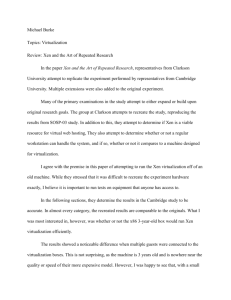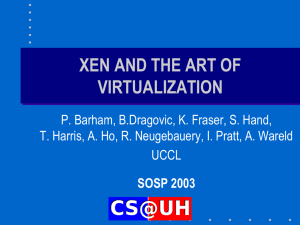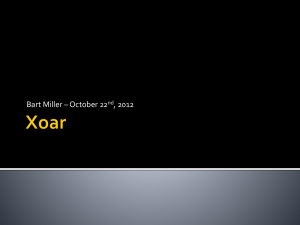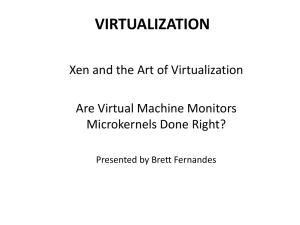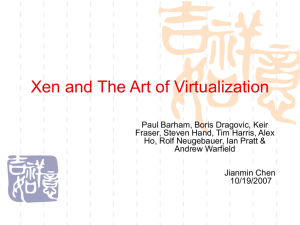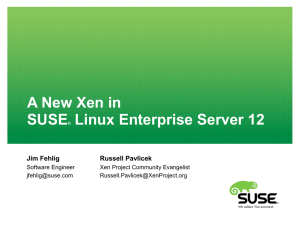Xen and the Art of Virtualization
advertisement
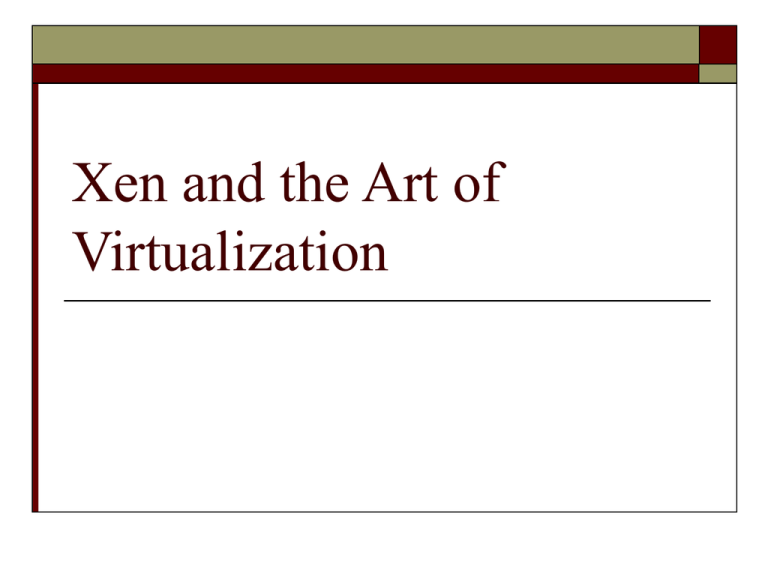
Xen and the Art of Virtualization Introduction Challenges to build virtual machines Performance isolation Scheduling priority Memory demand Network traffic Disk accesses Support for various OS platforms Small performance overhead Xen Multiplexes resources at the granularity of an entire OS As opposed to process-level multiplexing Price: higher overhead Target: 100 virtual OSes per machine Xen: Approach and Overview Conventional approach Full virtualization Cannot access the hardware Problematic for certain privileged instructions (e.g., traps) No real-time guarantees Xen: Approach and Overview Xen: paravirtualization Provides some exposures to the underlying HW Better performance Need modifications to the OS No modifications to applications Memory Management Depending on the hardware supports Software managed TLB Associate address space IDs with TLB tags Allow coexistence of OSes Avoid TLB flushing across OS boundaries Memory Management X86 does not have software managed TLB Xen exists at the top 64MB of every address space Avoid TLB flushing when an guest OS enter/exist Xen Each OS can only map to memory it owns Writes are validated by Xen CPU X86 supports 4 levels of privileges 0 for OS, and 3 for applications Xen downgrades the privilege of OSes System-call and page-fault handlers registered to Xen “fast handlers” for most exceptions, Xen isn’t involved Device I/O Xen exposes a set of simple device abstractions The Cost of Porting an OS to Xen Privileged instructions Page table access Network driver Block device driver <2% of code-base Control Management Separation of policy and mechanism Domain0 hosts the application-level management software Creation and deletion of virtual network interfaces and block devices Control Transfer: Hypercalls and Events Hypercall: synchronous calls from a domain to Xen Analogous to system calls Events: asynchronous notifications from Xen to domains Replace device interrupts Data Transfer: I/O Rings Zero-copy semantics CPU Scheduling Borrowed virtual time scheduling Allows temporary violations of fair sharing to favor recently-woken domains Goal: reduce wake-up latency Time and Timers Xen provides each guest OS with Real time (since machine boot) Virtual time (time spent for execution) Wall-clock time Each guest OS can program a pair of alarm timers Real time Virtual time Virtual Address Translation No shadow pages (VMWare) Xen provides constrained but direct MMU updates All guest OSes have read-only accesses to page tables Updates are batched into a single hypercall Physical Memory Reserved at domain creation times Memory statically partitioned among domains Network Virtual firewall-router attached to all domains Round-robin packet scheduler To send a packet, enqueue a buffer descriptor into the transmit rang Use scatter-gather DMA (no packet copying) A domain needs to exchange page frame to avoid copying Page-aligned buffering Disk Only Domain0 has direct access to disks Other domains need to use virtual block devices Use the I/O ring Reorder requests prior to enqueuing them on the ring If permitted, Xen will also reorder requests to improve performance Use DMA (zero copy) Evaluation Dell 2650 dual processor 2.4 GHz Xeon server 2GB RAM 3 Gb Ethernet NIC 1 Hitachi DK32eJ 146 GB 10k RPM SCSI disk Linux 2.4.21 (native) Relative Performance 1 1 0.9 0.9 0.8 0.8 0.7 0.7 0.6 0.6 0.5 0.5 0.4 0.4 0.3 0.3 0.2 0.2 0.1 0.1 0 Linux Xen VMWare UML 0 Linux Xen VMWare UML SPEC INT2000 score SPEC WEB99 CPU Intensive 180Mb/s TCP traffic Little I/O and OS interaction Disk read-write on 2GB dataset Concurrent Virtual Machines Multiple Apache processes in Linux vs. One Apache process in each guest OS Performance Isolation 4 Domains 2 running benchmarks 1 running dd 1 running a fork bomb in the background 2 antisocial domains contributed only 4% performance degradation Scalability

